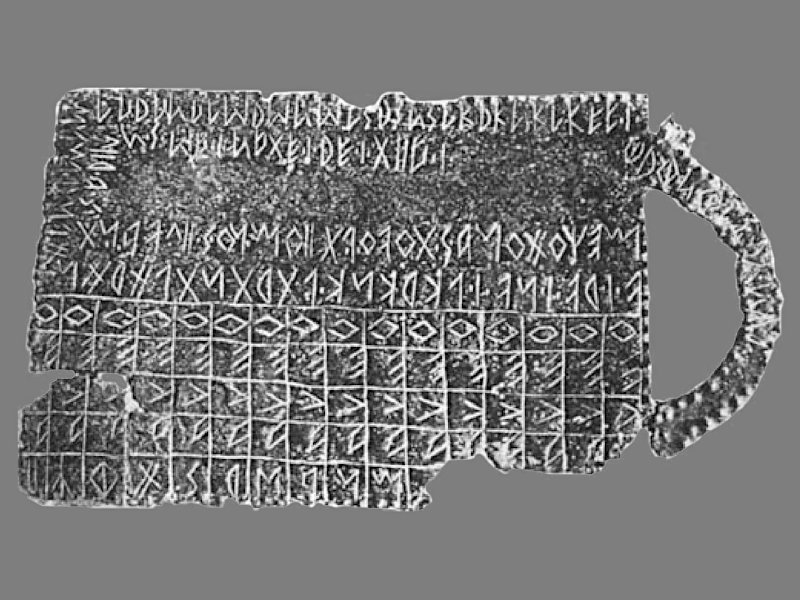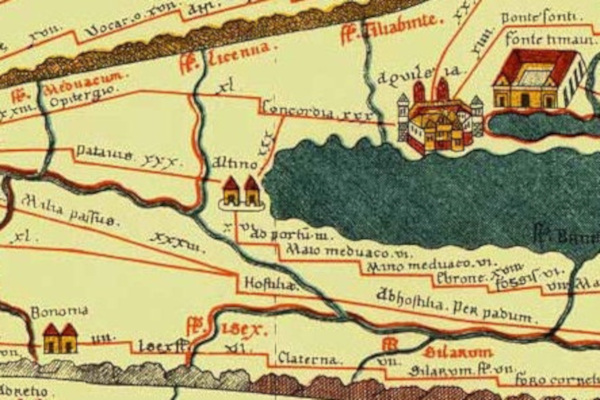SaInAT-Ve
Sacred Inscriptions from the Ancient Territory of Venetia
About
This project aims to investigate the interaction between writing and religion in ancient north-eastern Italy from the 3rd century BCE to the 1st century CE and covers the area described by the Roman historian Livy as the Venetorum angulus (5.33.10), which was later included by the first emperor Augustus in the administration of the tenth region of Italy (regio X). By adopting an interdisciplinary and cross-temporal approach, the project addresses cults and rituals through the lens of epigraphy to understand their role in promoting the religious and political integration of indigenous societies into the Roman world. Our dataset comprises a range of epigraphic documents from a variety of indigenous cultures (Celtic, Raetic, and Venetic), as well as a large body of so-called ‘sacred inscriptions’ written in Latin, ranging from the earliest contacts of the Romans in north-eastern Italy to the full integration of local communities into the Roman political system.
The project’s acronym, SaInAT-Ve, notably alludes to the Venetic form Sainat-, a highly debated divine epithet, through which several Venetic inscriptions identify the role of some of the most important local deities.
Sacred inscriptions (tituli sacri) have long played a crucial role within the taxonomy of epigraphic corpora. During the last decades, epigraphy has remarkably advanced not only as a discipline based on philological criticism, but also as part of a renewed scientific approach investigating ancient monuments and contexts through cutting-edge methodologies.
Within this epistemic reappraisal, epigraphic documents that relate to the sacred sphere have not lost their primacy, but the international scholarly community has increasingly become aware that the study of places of worship and the understanding of ritual practices essentially require multiple sets of evidence. In order to discern religious experiences through time and space, it is necessary to encompass a wide range of primary sources (literary, archaeological, topographical, epigraphic, numismatic, etc.) and combine them with different areas of expertise (historical, religious, anthropological, sociological, and linguistic). These principles have inspired recent publication projects, such as the proceedings of the Sacrum facere seminars and the Fana templa delubra corpus.
With regard to the ancient Venetia region, the relationship between epigraphy and religion has recently attracted more scholarly attention. A significant number of places of worship have been the object of specific investigations. All these sites have produced a variety of epigraphic documents in both Venetic and Latin, and – to a lesser extent – in Celtic and Raetic, all related with a votive function.
SaInAT-Ve aims at freshly building on the results of previous research, part of which has been carried out by specialist members of our team. In particular, we are focusing on ancient contexts, which have already been the object of archaeological excavations and have produced considerable written documentation related to the sacred sphere, such as the sites of Altinum, Ateste and Lagole di Calalzo.

By Giorgio Roncolato, Wikimedia Commons.
Research
Goals
The purpose of our project is to investigate the processes of integration of local societies into the Roman political system with a special focus on the role played by religion and its ritual aspects. By combining primary evidence with an interdisciplinary approach, the project intends to shed new light on the network of contacts woven between the indigenous communities from north-eastern Italy and Rome in a long-term perspective.
Since the practice of epigraphic writing played a crucial role in the religions of the Venetia region, special attention is devoted to the study of inscribed evidence. In particular, we are tackling the following scientific questions:
- can expressions or formulas (sacred prescriptions, calendars with festivals, offerings, fulfilments of vows, sacrifices) clarify rituals?
- can the study of the ways of writing texts (e.g., painted or engraved inscriptions, stamps, graffiti) help us identify their authors (professional stone carvers, priests and priestesses, or the worshippers themselves)?
- can texts provide information about the time (public festivals, recurrent ceremonies, seasonal cycles) and places of worship (display, storage, hanging, posting-up, removal, de-functionalization) in which sacred inscriptions were set up?
- do texts and iconographies (if present) reflect any ritual gestures and actions (prayers, sacrifices, processions, readings, songs, dances, music)?
We expect a comprehensive investigation to help us answer these questions and draw conclusions on specific aspects of rituals, their purposes and their spatial and social contexts. In order to investigate a diversified set of ethnic and cultural situations, we are devoting our attention to different cult places, which are firmly grounded in the recent results of archaeological research and reflect the state of the art in the field.
Our final goal is to trace primary sources back to their original contexts. We have also decided to diversify our geographic coverage and extend it to both cities and rural areas, in the mountains as well as in the plain. Given the major role played by rivers, lakes, springs, marshes, channels, and the Adriatic Sea, specific attention is devoted to the cultic role of water in different ritual landscapes.
Impact
The SaInAT-Ve project pays special attention to disseminating the results of the project to a wider -specialist and non-specialist - audience. In this respect, a varied range of digital products will be exploited, such as podcasts, 3D renderings and 3D prints, all embracing the standards of Open Research Data. We fully support the ‘Plan S’ and ‘cOAlition S’ initiatives, and our publications will be licensed under a Creative Commons Attribution 4.0 International Licence. Each resource will also be linked to those already available on the web by adhering to the FAIR principles (Findable, Accessible, Interoperable, Reusable) and according to the paradigm of Linked Open Data.
In particular, SaInAT-Ve aims to fully comply with the standards of the new European Framework Programme for research and innovation “Horizon Europe” with regard to Open Science, social impact and the enhancement of the quality of life of European citizens.
Scientific results will be disseminated thanks to a final conference, which will be available for online viewing via streaming and recorded on the Ca’ Foscari University of Venice social media channels. The proceedings of the conference will be published in a peer-reviewed edited volume in Diamond Open Access format.

By Holapaco77 - Own work, CC BY-SA 4.0, Link
Digital map of ancient “Venetia”
This map displays part of the epigraphic and archaeological records investigated by the SaInAT-Ve project interdisciplinary working groups.
The goal of the map is twofold: first, to facilitate the comparison of different categories of data and primary sources; second, to provide an accessible tool for sharing the results of scientific research with a non-specialist audience. The map is developed in a GIS environment and is freely available online.
Through the map, it is currently possible to visualise seven different layers, with the potential for future expansion:
- «Bibliografia» (in black) collects the relevant scientific literature for studying the ancient religious systems of each site.
- «Iscrizioni latine» (in red) includes the sacred Latin inscriptions of each site, with links to their EDR - Epigraphic Database Roma [ITA] entries and to their 3D models, where available.
- «Iscrizioni venetiche» (in blue) maps the sacred Venetic inscriptions found in each ancient sanctuary, with links to their 3D models, where available.
- «Iconografia preromana» (in grey) maps the distribution of three categories of objects bearing iconographic information: bronze plates, statuettes and discs from both the pre-Roman and the Romanization periods.
- «Archeozoologia» (in white) maps the archaeozoological remains from three sanctuaries: Altino Fornace, Este Meggiaro and Este Baratella.
- «Monete» (in orange) records the number of coins found in each ancient sanctuary and grouped according to their typology and chronology.
- «Aes Rude» (in yellow) registers the number of aes rude found in each ancient sanctuary, along with information on whether they come from stratigraphic or non-stratigraphic excavations.
International conference
«Writing and Religious Traditions in the Ancient Western Mediterranean»
The final event of the SaInAT-Ve project will be an International Conference devoted to «Writing and Religious Traditions in the Ancient Western Mediterranean», which will take place at Ca’ Foscari University of Venice from 23 to 25 November 2023.
To attend the conference online, please register via Zoom.
|
|
Conference flyer | 590 KB |
Posters
|
|
Poster 1: Federica Spagnoli, Giuliana Bonanno, Tecla Zucchi
"The Sanctuary of Astarte at Ras il-Wardija in Gozo between Carthage and Rome: Cults, Rituals, and Religious Entanglements of a Mediterranean Sanctuary (4th century BC - 2nd century AD)" |
1 MB |
|
|
Poster 2: Alfredo Tosques
"The Frentrani of Sicily and the Shrine of Hercules Nouritanus in Lilybaeum (AE 2016 , 622 = I.Sicily 004368)" |
1 MB |
|
|
Poster 3: María José Estarán Tolosa
"The CULTURE Project. The Role of Writing in Cult Places in Italy and Gaul and the Impact of Roman Epigraphic Culture" |
2 MB |
|
|
Poster 4: Alberto Barrón Ruiz de la Cuesta
"Religious Offerings from Seviri and Seviri Augustales in Venetia et Histria" |
632 KB |
|
|
Poster 5: Niccolò Gerardo, Anna Clara Maniero Azzolini, Marta Mielli, Rebecca Oliva [ITA]
"Aspetti del sacro e della ritualità nella Venet ia. Quattro approfondimenti su offerte, divinità e frequentazione di alcuni loci sacri della X regio" |
1 MB |
|
|
Poster 6: Tommaso Fantin [ITA]
"Il santuario di Lagole di Calalzo. La documentazione epigrafica in lingua latina" |
2 MB |
|
|
Poster 7: Ludovico Bevilacqua [ITA]
"Il caso singolare dei fanorum curatores veronesi: status quaestionis e possibili identificazioni" |
983 KB |
|
|
Poster 8: Sofia Comini, Francesca Corsi, Marco Vittorio Pezzolo, Cecilia Silvestrin [ITA]
"Minerva, Camuni e Romani: le tre ‘facce’ della mensa votiva triangolare da Breno (BS)" |
880 KB |
Team
Lorenzo Calvelli
Principal Investigator
Associate Professor in Ancient History and Latin Epigraphy
Giovannella Cresci
Emeritus Professor in Ancient History and Latin Epigraphy
Sabina Crippa
Associate Professor in History of Religions
Giovanna Gambacurta
Associate Professor in Etruscology and Italic Archaeology
Tomaso Maria Lucchelli
Associate Professor in Ancient Numismatics and Economic History of the Ancient World
Anna Marinetti
Full Professor in Historical Linguistics and Languages of Ancient Italy
Patrizia Solinas
Associate Professor in General and Indo-European Linguistics
Members
Sabrina Pesce
Post-doctoral Fellow in Ancient History and Latin Epigraphy
Luca Rigobianco
Researcher in Historical Linguistics and Languages of Ancient Italy
Partners
- International Centre for the Study of Religions in the Ancient Mediterranean [ITA], Ca' Foscari University of Venice
- Direzione Regionale dei Musei del Veneto [ITA]
- Warwick Manufacturing Group (WMG), The Univesity of Warwick
- International Association of Greek and Latin Epigraphy (AIEGL)
- Terra Italia Onlus [ITA]
- Deputazione di Storia Patria per le Venezie [ITA]
- Europeana Network of Greek and Latin Epigraphy (EAGLE)
- International Digital Epigraphy Association (IDEA)









